The question is as old as the powered aviation itself: Assuming a single-engine airplane, if power is lost immediately after takeoff, should you land straight ahead or try to get back to the airport? This magazine has often addressed the question, including a January 2006 article by spinmeister Rich Stowell. Rich detailed the results of a simulator-based study examining “the feasibility of successfully executing a 180-degree turnaround following an engine failure at 500 feet agl.” The study concluded that practicing the maneuver boosted its success rate, but landing straight ahead (or nearly so) had a higher success rate.
For decades the FAA tried to make the decision for us, dubbing the return-to-runway attempt “the impossible turn.” It’s never worth the risk, the FAA told us. Yet, current FAA guidance still requires instructors to train pilots on maneuvering back to the runway in the event of engine failure. Should we land straight ahead, or turn back to the runway? Is returning to the runway following a power loss after takeoff an all-or-nothing decision?
The Impossible Turn
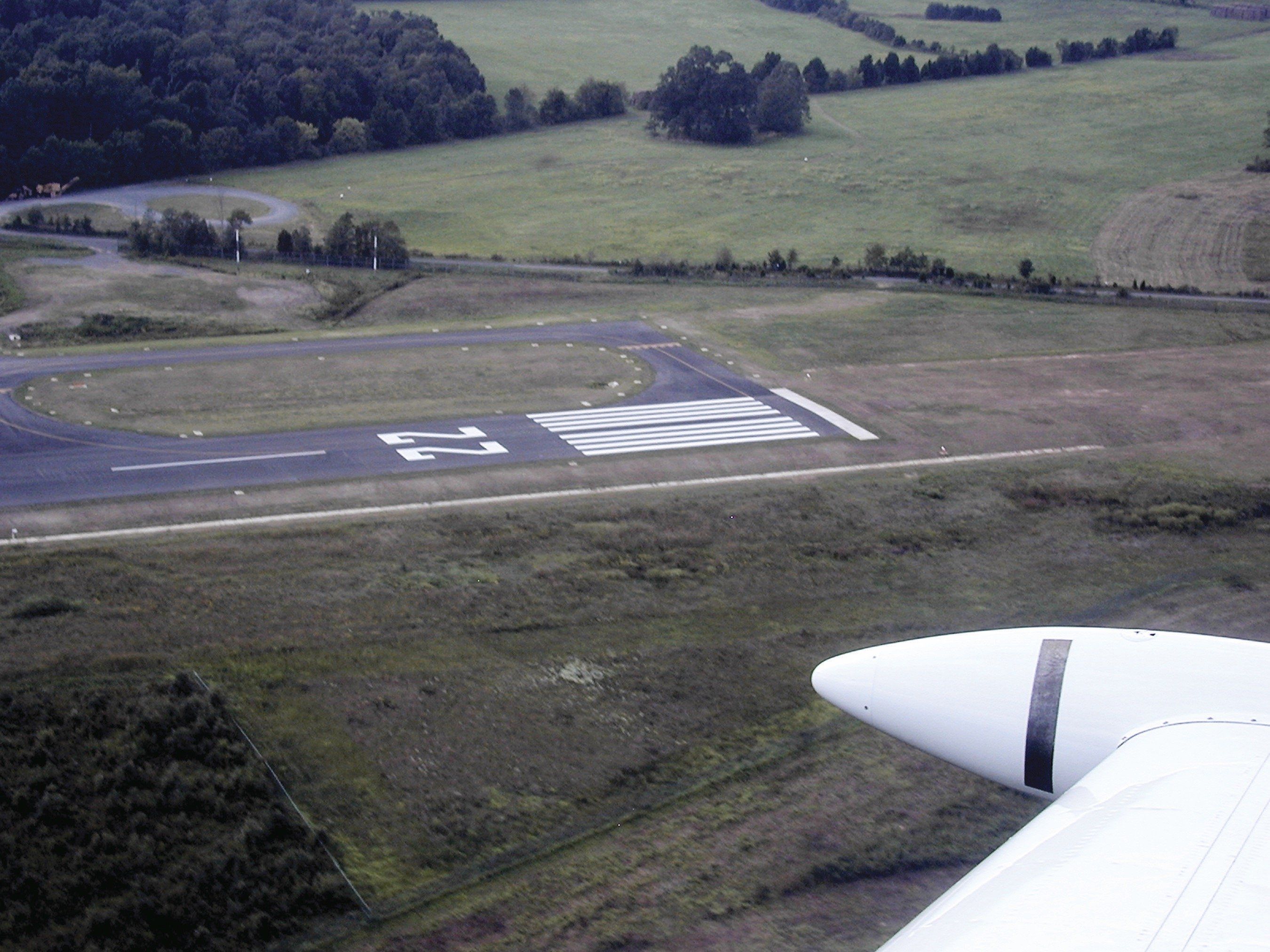
In 2017, the FAA updated its guidance on engine failure shortly after takeoff. The result, The Impossible Turn (FAA-P-8740-44, available as a PDF at tinyurl.com/SAF-Turn), is a comprehensive and well-written document whose very first sentence sums up its recommendations in bold print: “Turning back is the worst possible action when the powerplant fails during climbout in a single.”
The document concedes: “No doubt there are a few, although very few, situations in which circumstances might dictate turning back. But, such decisions, demanding split second action and supreme skill, are beyond the capabilities of the average pilot.”
Even then, however, the FAA concludes: “It’s better by far to establish a well-rehearsed emergency drill and keep in practice, so that should the engine go on strike, there will be no “shall I/shan’t I” nonsense while time runs out.”
For at least the 35 years I’ve been a pilot, landing straight ahead-no exceptions-has been the FAA’s guidance when an engine fails on takeoff. So what changed?
The FAA’s Now-Possible Turn
The FAA’s September 2018 Advisory Circular AC 61.83J (“Nationally Scheduled, FAA-Approved, Industry-Conducted Flight Instructor Refresher Course,” available as a PDF at tinyurl.com/SAF-FIRC) addresses approving Flight Instructor Refresher Clinics (FIRCs), the predominant way flight instructors meet their certificate renewal requirements. The AC tasks flight instructors with teaching student pilots what for years it called “the impossible turn.”
In an appendix, the AC states, “Flight instructors should demonstrate and teach trainees when and how to make a safe 180-degree turn back to the field after an engine failure. Instructors should also train pilots of single-engine airplanes not to make an emergency 180-degree turn back to the field after a failure unless altitude, best glide requirements, and pilot skill allow for a safe return. This emergency procedure training should occur at a safe altitude and should only be taught as a simulated engine-out exercise.”
Additional guidance and several qualifiers that are important factors in presenting this maneuver follow, and are vital to a successful attempt in the event of a real-world departure engine failure. The guidance and caveats are too lengthy to repeat here. Get a copy of the AC at the link provided and see for yourself.
Is all this really a change in the FAA’s philosophy regarding the wisdom of attempting a return to the runway with a failed engine? Or is the intent of the FIRC guidance to convince pilots that the turn is impossible most of the time? Your guess is as good as mine (and the rest of the instructor community’s). Regardless, let’s look at some of the empirical challenges in making what, for many, remains an impossible turn.
Options
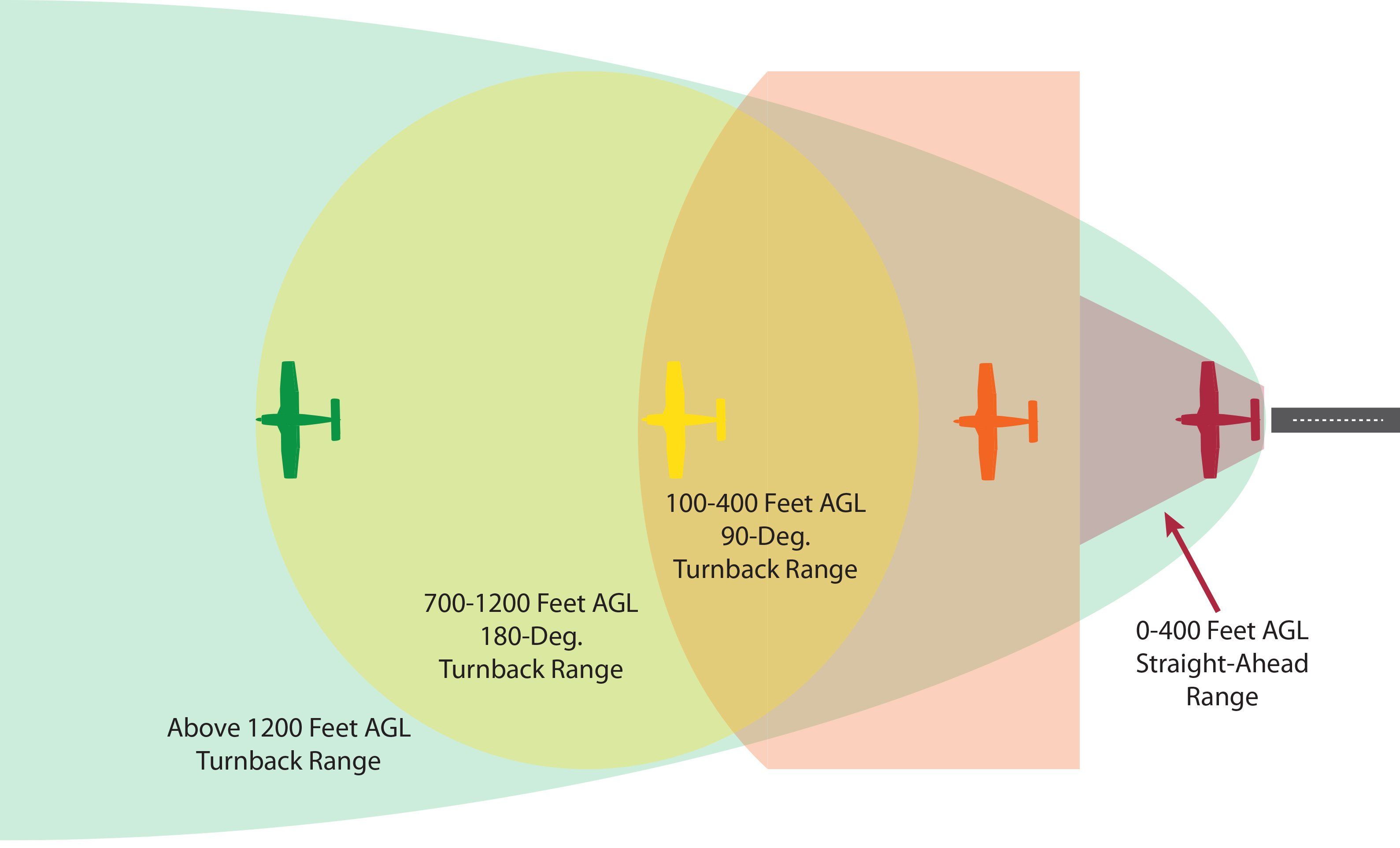
Everything I’ve written so far in this article can be summed up thusly: It’s extremely challenging, and rarely possible, to lose an engine immediately after takeoff, overcome the startle factor and establish maximum-performance control, and then to successfully return to land on the departure runway behind you. Put out of your mind the idea you’ll lose the engine, turn around, line up on the reciprocal runway, put the landing gear back down if applicable, roll onto a smooth touchdown and radio the FBO to come tow you in. It virtually never happens-which is why it’s such a big deal in the rare cases it does.
Many pilots argue that there are no good options straight ahead from some of the airports they use, even their home airports, and that turning back to the runway is the only option. Almost no one considers, however, that “straight ahead or back to the runway” isn’t an all-or-nothing decision. When it comes to surviving engine failure after takeoff, you may have more options.
Think of your initial climb after departure as including a series of decision altitudes. Each altitude describes an expanding range of options that become available to you in the event of engine failure. Announce this “range awareness” to yourself as you climb through each decision altitude. With the image above as a visual explanation, here’s what I mean:
Runway range: The first, and arguably most important, range for dealing with engine failure is before you ever leave the ground. Complete all checklist steps and don’t rationalize away a little roughness or an errant pressure or temperature discrepancy-it probably won’t get better as you take off, and it just might be predicting an impending failure. During takeoff, crosscheck power, temperature and pressure indications against expectations, and measure acceleration against predictions. For example, you should be at 70 percent of the liftoff speed when reaching 50 percent of the computed takeoff distance. If there are discrepancies before or during takeoff, abort and check it out. Most of the time, engines don’t go from 100-percent reliable to partial or total failure without some advance warning. Listen and watch what the engine is telling you, and heed warnings before they become failures.
Straight-ahead range: From the moment the wheels leave the surface until the airplane is at least 400 feet AGL, your only real option in the event of engine failure is to go virtually straight ahead. You probably have less than a minute to prepare to touch down, less if you move lift away from the vertical to make the airplane turn. (My primary instructor advised me to land straight ahead with only minor heading changes “to avoid orphanages and school buses.”) Figure no more than maybe 20 degrees left or right of your heading if the engine quits within 400 feet of the ground. Why 400 feet? Instrument pilots know this is the lowest altitude before making a turn when cleared for a takeoff on course or a heading other than runway heading. It’s an altitude we should be briefing anyway, so dual-purpose it for engine failure range also.
90-degree range: Between 400 AGL and about 700 feet AGL, you may be able to turn as much as 90 degrees left or right to align with the best landing option. To survive this, you need to know ahead of time what that option will be. Look at Google Earth or another depiction of the area off the departure end to make this decision before you board the airplane.
180-degree range: Passing 700 feet AGL and through about 1200 AGL, you are in the range where you may be able to turn up to 180 degrees to align with the best landing option. This still does not put you back on the runway you departed, unless you’re turning steeply into a stiff wind. But it might put you in position to land on an unoccupied taxiway or parallel runway, or at the very least on level airport property, perhaps the infield.
Runway range: Above 1200 feet AGL, you should have enough altitude to actually get back to the runway behind you…if you do everything quickly and correctly. If the runway is short, you may find you get turned around and lined up, but are far enough out you can’t make it back to the runway.
Regardless of the range and the options you attempt, when you glide back through 400 feet AGL, level the wings and land on the best option that’s about straight ahead. Trying to finish a turn at a low altitude is inviting a potentially disastrous cartwheeling arrival when you and your passengers could survive otherwise.
Making It Happen
Your objective is survival for your passengers and yourself. You may find it advantageous to land gear-up in a retractable gear airplane, if extending the gear makes the difference whether you’ll reach your landing zone. Airline captain Brian Schiff advises that “a turnback should be attempted only when it is more hazardous not to.” I agree completely-take the best option that your preflight briefing tells you is available.
Straight ahead or back to the runway, however, it’s not an all-or-nothing decision. You have a range of options that vary with your altitude, taking into account the variables of a successful engine-out landing. If you’ve prepared yourself and maintain good range awareness, you have the best chance of surviving an engine failure just after takeoff.
Do the Math
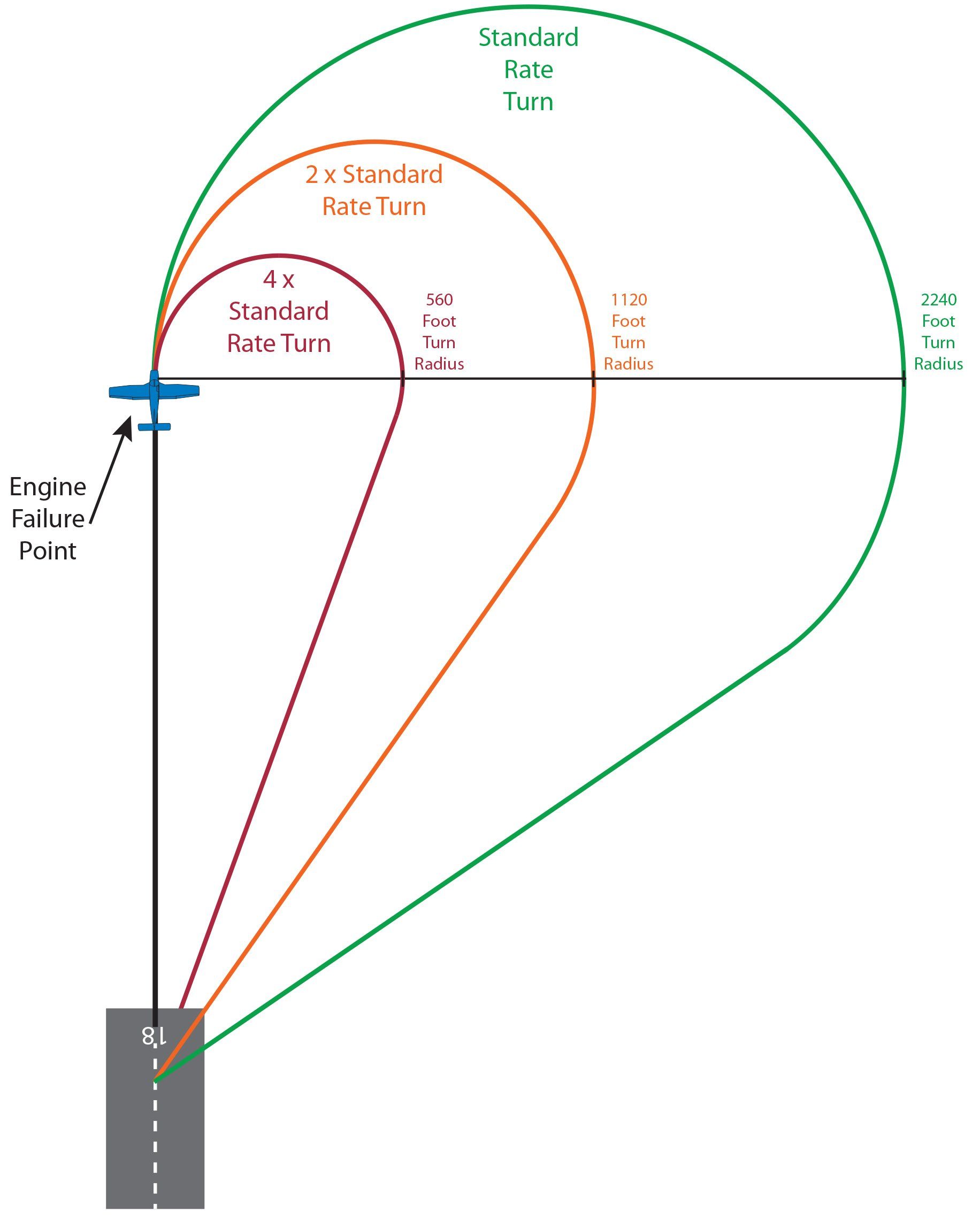
The effects of standard rate, twice standard rate and four times standard rate are based on the turn radius at 70 KIAS (best glide speed in a typical light four-seat airplane). Standard rate bank angle at 70 knots is roughly 11 degrees; twice standard rate is about 22 degrees while four times standard rate is approximately a 45-degree bank. This is graphically presented in Figure 1. Omitted from this graphic is the extent to which an additional low-altitude turn is required to align with the runway before touching down.

Turnback data for a typical four-seat airplane from FAA-P-8740-44 is at right in Figure 2A. “The Impossible Turn” assumes a 1000-fpm descent in a standard-rate turn for a typical four-seater. Figure 2B presents the results of flight-testing in an A36 Bonanza at its 110-knot glide speed.

Thanks to the reduced vertical component of lift in a turn, the right column assumes 1.5 times the rate of descent in a twice-standard-rate turn and twice the rate of descent at four times standard rate. Importantly, neither table includes altitude lost during the “startle factor” pause or any straight-line time or altitude lost after pointing back at the airport but before making the last turn to align with the runway. Your mileage may vary.
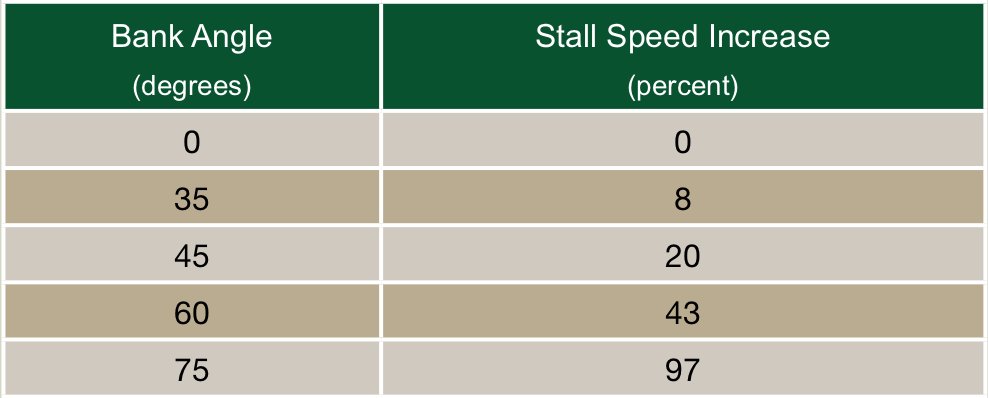
Figure 3 shows the relationship between bank angle and increased indicated stall speed in coordinated flight, also from FAA-P-8740-44. The data are valid in level flight only-actual stall speed increase depends on load factor. If the pilot allows the airplane to descend at 1G, there is no increase in stall speed. In practice, the emergency pilot will probably increase back pressure somewhat while still allowing the airplane to descend, so the actual stall speed increase will be something less than tabulated.
Range Awareness
For several years I’ve been teaching the concept of how altitude determines your options after the engine fails, but I’ve only recently begun using the term “range awareness.” I am borrowing it from my friends and counterparts in the Cirrus community who use “range awareness” to describe when to use the Cirrus Aircraft Protection System (CAPS) airframe parachute for engine failures shortly after takeoff.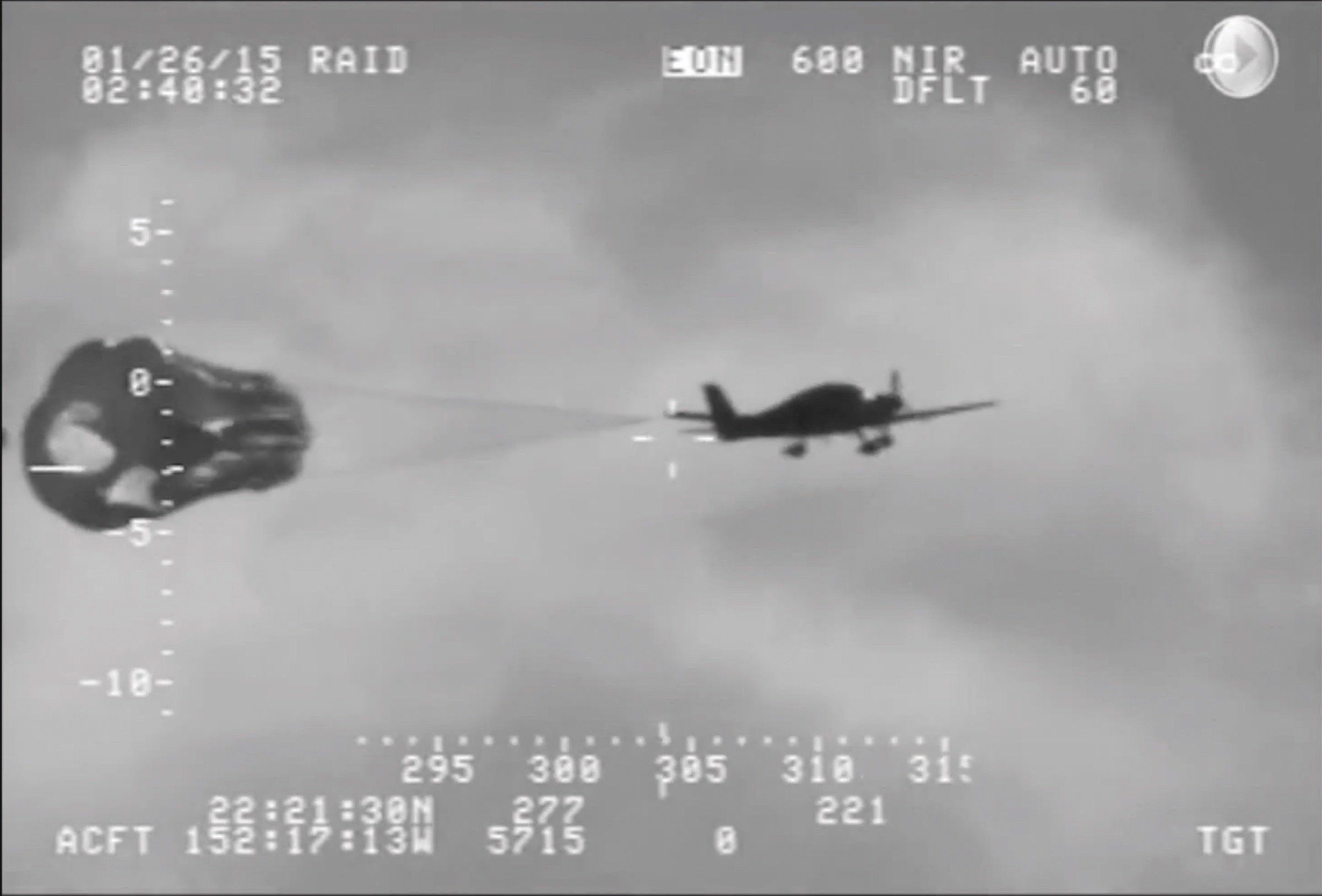
The Cirrus Owners and Pilots Association (COPA) teaches three CAPS ranges for takeoff: from liftoff to 400 AGL is the “No CAPS” zone, because the airplane will descend about 400 feet (500 feet in some models) during parachute deployment and inflation. Below 400 AGL (or 500 AGL, again by model) the Cirrus pilot has the same option as pilots in non-CAPS-equipped airplanes: land straight ahead. COPA teaches that 400-500 feet AGL to 2000 feet AGL is the “CAPS Now” range. Pull the ‘chute at the first sign of engine failure, because the chances of a stall/spin or descent into unfavorable obstacles is historically great and the COPA doesn’t want the pilot to risk it.
Above 2000 feet AGL is COPA’s “Consider CAPS” range-respond to engine failure like the rest of the non-parachute crowd. If the engine won’t restart, and when descending through 1000 feet AGL there is no good landing option within comfortable gliding range, then deploy the CAPS.
COPA’s concept of altitude range awareness, and a briefed, practiced response to engine failure based on altitude range, is well-suited to helping us all prepare to survive engine failure shortly after takeoff.

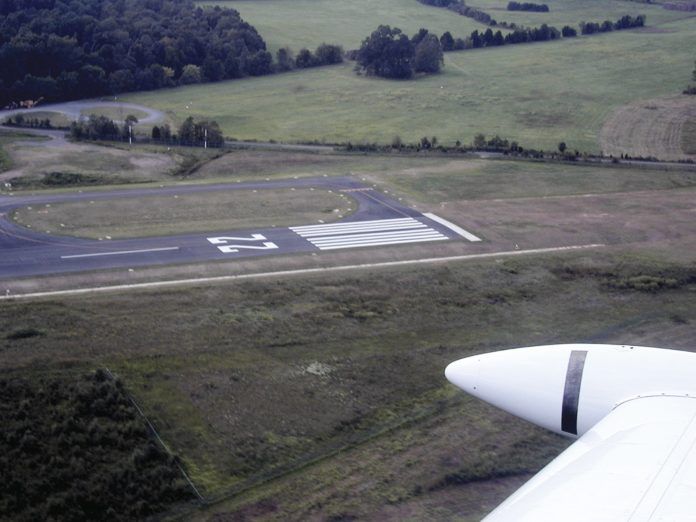



Good discussion on how to consider altitude for various engine out situations. If the goal is to actually land on the departure runway reciprocal, the great data tables miss an important point. The math needs to include time, displacement and altitude lost during all maneuvering in a return to the departure runway. Diagrams like the one in this article showing a miss aligned arrival at the threshold and makes the point. To find the correct minimum altitude needed, we first note that for a return to the departure runway, a series of turns totaling 360° heading change is needed. One way to look at the maneuver is that of a turn of 180° which will get us to the departure reciprocal heading but includes a lateral displacement from the departure runway. That lateral displacement is the turn diameter, or if you like, double the turn radius . The second and third turns are opposites of 90° each. Both are needed, the first take out the lateral separation created in the 180° turn, and the second to re-align with the departure heading reciprocal. Or one could consider a 270° turn followed by an opposite 90° turn to align. In either case, your turning decent rate over 360°, at given angle of bank, will tell you your minimum altitude for a return to the departure runway. Less than 360° will give you a miss aligned arrival. That calculation does not include time to transit any down range or cross range displacement beyond the displacement of the turns themselves. There is also no allowance for the pilot reaction time or weather variables. As they say “your mileage may vary”. This is easy to practice at altitude. Go see what your plane and pilot skills produce for a decent rate at max glide speed and various angles of bank. Make your data table for your plane.
Very good article! Thinking about where you are going when things go wrong as part of the preflight briefing could be worth a few hundred feet of altitude….
I have been teaching this for many years, always good to have another option, or two!
I just attended a FAASafe seminar
GL15103785
The Impossible Turn
It had some very interesting analysis that a guy had done. and some actual testing at altitude. A major factor in his analysis was the headwind that you are taking off in. in his modeling a headwind of 18 knots in the Cherokee 140 would allow a return to the airport. much less in a RV 9 was necessary.
the other major factor was the glide angle of the aircraft compared to the normal climb angle. If the climb angle was substantially steeper than the glide angle, you also had a better chance of success.
I have read these impossible turn articles frequently and they all assume total loss of power. Just as likely is partial loss of power, which gives you more options. Having experienced a cracked cylinder and a “bucking” PA-28-180 aircraft at 500 feet after take-off, there was no math or analysis involved besides the basics: get to best glide speed, stay above stall speed (which increases during a turn), stay above the houses and trees, put out a radio call to the other planes in the pattern, and gently turn toward the airport and land. By the time you turn back at this altitude, you do not have the option to land on the opposite runway because you have eaten most of it up with the gradual turn, so travel downwind only as much as needed to target the runway you departed (or a closer one if it is available) an land on it. Let’s start talking about the possibility of partial power in these discussions which is just as likely to happen and allows for additional options!
Sure, start with practice altitude but after you think you know what your minimum turn around altitude is, try the impossible turn at that AGL altitude. It’s much different experience being close to the ground doing a 45° or more bank while rapidly loosing altitude. You want that ground rush experience to be first encountered during practice when you have a fully functional engine to fall back on.
I have done this turn around maneuver many times in my Husky at a remote grass field. I agree with you. Learn the basics at altitude, but you need to eventually get actual practice taking off, simulating engine failure, and returning to the field. Looking at the ground in a 45 degree bank nose low attitude at low altitude is a totally different experience than simulating it at higher altitude. I tell my students it is a LEARNED maneuver and you don’t want to learn it the first time your engine fails. I’m an older guy who flew a Pitts in the IAC for years and you need solid stick and rudder skills to perform this maneuver. Michael Church (owner of Sunrise Aviation), who wrote and published an article on the same subject, gave a presentation at Oshkosh a couple of years ago. If I recall correctly, he has experienced five engine failures at various phases during takeoff in his career and was able to return to land each time. I emphasize to ALL students that I am not advocating turning around when losing power on takeoff, but only expanding your alternatives if that happens. The pilot will always need to use good judgement and good piloting skills.
I highly recommend the article “Minimizing Takeoff Risks in Flying Magazine”, April-May issue, 2021, starting on page 45.